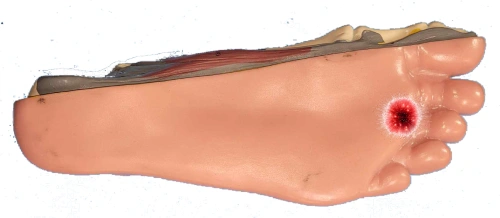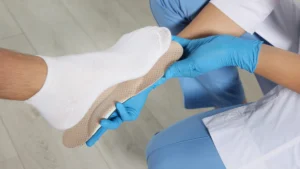It’s crucial to understand how the right orthotics can significantly reduce Morton’s neuroma pain. This common foot condition can cause discomfort and limit your daily activities. By following these ten crucial steps, you can learn how to select and use orthotics effectively and make a positive impact on your foot health. Whether you’re an avid runner or simply looking to ease your discomfort, these guidelines will empower you to take control of your foot care strategy.
Identifying the Symptoms and Triggers of Morton’s Neuroma
Understanding the symptoms and triggers of Morton’s Neuroma is crucial for managing your pain effectively. This common foot condition often manifests in the form of discomfort between your toes, particularly between the third and fourth digits. Recognizing these symptoms early can help you prevent further complications and seek appropriate treatment.
Common indicators of Morton’s Neuroma pain
Common signs of Morton’s Neuroma include sharp, burning pain in the ball of your foot, tingling or numbness in your toes, and an ache that worsens with certain footwear. You may also experience a sensation of having a pebble in your shoe, which can make walking uncomfortable.
Lifestyle factors that exacerbate the condition
Certain lifestyle choices can intensify your Morton’s Neuroma symptoms. Factors such as high-impact activities, inappropriate footwear, and prolonged pressure on your feet can contribute to the pain you experience. Addressing these aspects can be vital in managing your condition effectively.
- High-impact sports or activities that put pressure on your feet
- Wearing tight, narrow, or high-heeled shoes
- Excessive standing or walking on hard surfaces
Assume that each of these factors may play a significant role in aggravating your Morton’s Neuroma. Evaluating your daily activities and making adjustments can lead to noticeable improvements in your symptoms.
- Being overweight (obesity), which adds more pressure on your feet
- Flat feet or high arches, which can alter foot mechanics
- Wearing poorly fitting shoes or orthotics
Assume that maintaining a healthy weight and choosing supportive footwear can alleviate stress on your feet, thereby reducing pain associated with Morton’s Neuroma. Being mindful of these lifestyle factors can empower you to make meaningful changes that support your foot health.
Orthotic Fundamentals: The Role of Custom Devices
In terms of alleviating Morton’s neuroma pain, custom orthotics play a vital role in improving your foot comfort and functionality. These devices are designed specifically to cater to your unique foot structure and gait, providing targeted support where you need it the most. With the right orthotics, you can significantly reduce pressure on the affected nerves and enhance your overall foot mechanics, leading to a more enjoyable walking experience.
How orthotics can transform foot mechanics
Orthotics can transform your foot mechanics by ensuring proper alignment and distribution of weight across your feet. By correcting any imbalances or misalignments, custom devices help reduce strain on specific areas, allowing for smoother, pain-free movement. As a result, you can enjoy an improved gait and overall comfort while walking or standing.
The science behind shock absorption and support
Custom orthotics are engineered with materials that provide superior shock absorption and support for your feet. This design helps to cushion your heel and arch, reducing the impact of each step. Improved shock absorption minimizes the stress on your forefoot, easing the discomfort associated with Morton’s neuroma and allowing you to stay active without pain.
The materials used in custom orthotics are specifically chosen to enhance shock absorption through their unique properties. For instance, memory foam or gel inserts can provide a soft yet supportive base that adapts to the shape of your foot, while stiffer components provide necessary arch support. This combination not only helps to alleviate pressure on the nerves but also contributes to improved overall foot health by protecting the structure as you walk or run. Proper shock absorption reduces the risk of injury and enhances your stability during various activities.
Selecting the Right Orthotic: Key Features to Consider
When choosing an orthotic to alleviate Morton’s neuroma pain, it’s vital to focus on specific key features to ensure you get the support your feet need. Look for orthotics that offer:
- Excellent arch support
- Ample cushioning
- Shock absorption properties
- Stretchable and breathable materials
- Lightweight design
- Adjustable fit
- Durability and resistance to wear
Knowing these features will empower you to make an informed decision that suits your lifestyle and foot structure.
Importance of Arch Support and Cushioning
Effective arch support and cushioning are vital for reducing pressure on the metatarsal area, ultimately relieving Morton’s neuroma pain. When you select orthotics with the right arch support, they help distribute your body weight more evenly across your feet, providing comfort during daily activities.
Materials that Enhance Comfort and Durability
Choosing the right materials in your orthotics plays a significant role in comfort and durability. Materials such as gel, EVA foam, or cork provide superior cushioning while offering varying degrees of stiffness and support. You should look for breathable fabrics to maintain foot hygiene and prevent discomfort that can exacerbate your condition. High-quality materials are also crucial as they ensure your orthotics last longer, making them a wise investment for your foot health.
Investing in durable materials means you can rely on your orthotics without worrying about wear and tear. Orthotics made from high-performance materials will mold to your feet over time, enhancing comfort and support. Additionally, materials that wick away moisture help keep your feet dry, reducing the risk of blisters and irritation. Opting for well-constructed and thoughtfully designed orthotics not only provides the comfort you need but also stands the test of time, allowing you to focus on managing your Morton’s neuroma effectively.
Overcoming Sizing Challenges: Getting the Perfect Fit
Finding the right fit for orthotics is vital to alleviating Morton’s neuroma pain. Uncomfortable or poorly sized orthotics can contribute to foot strain and exacerbating symptoms. To ensure optimum comfort and support, you need to take precise measurements and consider the specific needs of your feet. This way, you can maximize the effectiveness of your orthotic treatment plan.
Steps to measure your feet accurately
To measure your feet accurately, start by gathering necessary tools like a ruler or tape measure. Stand on a piece of paper and trace your foot outline. Measure the length from the heel to the longest toe and the width at the ball of your foot. Repeat this for both feet, as they may differ in size. It’s best to measure in the evening when your feet are most swollen for a more accurate fit.
Custom vs. over-the-counter solutions
When choosing orthotics, you’ll often face the decision between custom and over-the-counter options. Custom orthotics are designed specifically for your foot’s unique structure, while over-the-counter versions are general fit products.
Custom orthotics offer a personalized solution tailored to your specific foot shape and condition, which can lead to better alignment and pain relief. They are typically crafted from high-quality materials and provide superior support for your arches. On the other hand, over-the-counter orthotics can be a cost-effective option, providing relief for mild symptoms or general foot fatigue. However, they may not address all your specific needs, which could limit their effectiveness for Morton’s neuroma. Assess your symptoms, lifestyle, and budget when making your choice for the best results.
Integrating Orthotics Into Your Daily Routine
Incorporating orthotics into your daily life can significantly enhance your comfort and alleviate Morton’s neuroma pain. Begin by gradually introducing them into your routine, allowing your feet to adjust to the added support. Use them consistently, whether at home, work, or out for a walk, to maximize their effectiveness. Keeping a pair of orthotics in your most frequently worn shoes ensures you’ll always have the necessary support, promoting your foot health as you go about your day.
Best practices for wearing orthotics
To achieve the best results from your orthotics, start wearing them for short periods and gradually increase the duration. This helps your feet acclimate and can minimize discomfort. Always ensure your orthotics fit snugly in your shoes without causing any pressure points. Regularly check for wear and tear, as this can affect their functionality, and consult a professional if you experience any changes in discomfort.
Adapting footwear choices for optimal relief
Your choice of footwear plays a significant role in managing Morton’s neuroma pain. Look for shoes that provide ample space for your toes, as constricting footwear can exacerbate your symptoms. Opt for shoes with a wide toe box, as they allow your orthotics to function correctly without additional pressure on your feet. Supportive soles and proper arch support are also important for improving overall comfort and reducing pain.
In addition to opting for a spacious toe box, consider the materials and design of your footwear. Shoes made from breathable materials can help maintain circulation, reducing discomfort further. Avoid high heels or narrow shoes, as they can compress your foot and aggravate neuroma symptoms. When purchasing new shoes, always try them on with your orthotics to ensure a proper fit and support system. Pairing the right footwear with orthotics can lead to a significant reduction in pain and allow for a more active lifestyle.
Moving Beyond Orthotics: Complementary Pain Management Strategies
While orthotics can provide significant relief for Morton’s neuroma pain, integrating additional pain management strategies can further enhance your comfort. Exploring a holistic approach that includes specific exercises, stretches, and alternative therapies can effectively address the discomfort and improve your overall foot health. By combining these strategies, you can create a personalized pain management plan that supports your recovery journey.
Exercises and stretches to alleviate discomfort
Incorporating targeted exercises and stretches into your routine can help alleviate discomfort associated with Morton’s neuroma. Focus on foot stretches that improve flexibility, strengthen the muscles of your feet, and encourage better alignment. Simple exercises, such as toe curls and arch lifts, can promote circulation and reduce tension in the affected area, providing you with greater relief.
When to consider medical interventions
If conservative measures, such as orthotics and stretching, do not adequately alleviate your pain, you may want to explore medical interventions. Persistent symptoms that interfere with daily activities could warrant an evaluation from a healthcare professional. In some cases, imaging studies or injections may be recommended, and in rare instances, surgical options could provide the relief you need to regain mobility and comfort.
Steps To Alleviate Morton’s Neuroma Pain Conclusion
Considering all points discussed, alleviating Morton’s neuroma pain through the use of the right orthotics can significantly enhance your comfort and mobility. By following these 10 imperative steps, you can effectively manage your symptoms and improve your overall foot health. Prioritize finding the appropriate orthotic support tailored to your specific needs, and don’t hesitate to consult with a healthcare professional for personalized advice. With the right approach, you can take charge of your foot health and enjoy a more active lifestyle.





